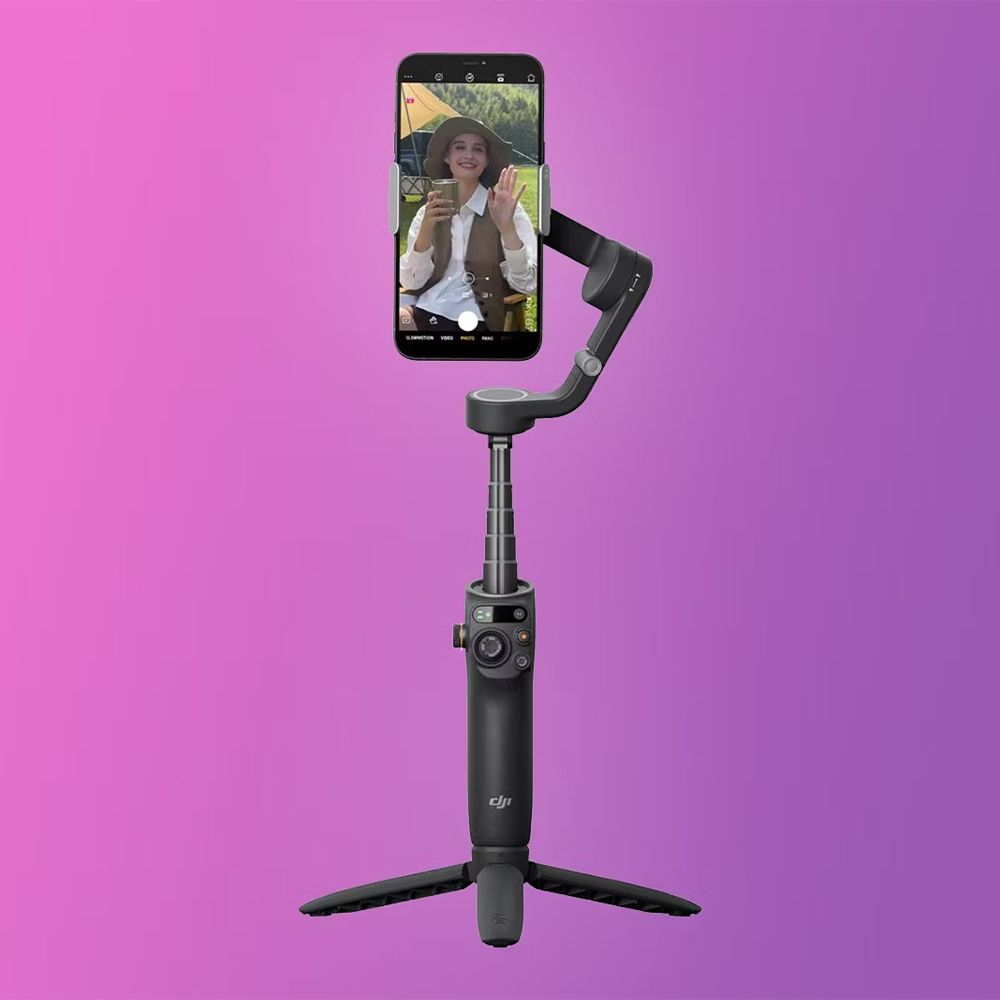-
Insta360
Insta360 Flow
Our top choice
$146 $159 Save $13
Insta360’s debut mobile gimbal instantly impressed us. It offers an exceptionally well-thought-out design with a built-in tripod and extension rod, and that’s backed up by some class-leading software features.
Pros- Ingenious design
- Extremely portable
- Excellent tracking capabilities
Cons- Built-in tripod is a little flimsy
-

DJI
DJI Osmo Mobile 6
Still an excellent option
$135 $159 Save $24
DJI has been the go-to smartphone gimbal brand for many years now, and its experience shows in the Osmo Mobile 6. While the Insta360 bests it in portability and tracking capabilities, the Osmo Mobile 6 is still a serious contender.
Pros- Very portable design
- Great build quality
- Tonnes of features
Cons- App requires sideloading on Android
To say Insta360’s first-ever smartphone gimbal is an impressive debut is quite an understatement. The Insta360 Flow has quickly cemented itself as one of the best options for anyone creating content with a mobile phone.
Until recently, DJI had been the undisputed champ of smartphone gimbals, it has spent years refining its designs and they’ve become some of the most popular options on the market.
The DJI Osmo Mobile 6 and the Insta360 Flow both come at the exact same price, and they offer a lot of similar features, too. So, you might be wondering which one is right for you. Let’s dive into the specs and find out.
Specs, availability and pricing
The DJI Osmo Mobile 6 was released in late September 2022 at a price of $159 and it has been available at retail ever since.
The Insta360 Flow was released later, in March 2023, and carries the exact same retail price as the Osmo Mobile 6. Clearly demonstrating Insta360’s ambition to compete with the smartphone gimbal of choice.
-
Insta360 Flow DJI Osmo Mobile 6 Selfie Stick Extendable to 8.5 inches Extendable to 8.5 inches Weight 369g 309g Charging Time 2 hours 1.5 hours Runtime up to 12 hours up to 6.5 hours Size 162.1×79.6×36 mm folded 189×84.5×44 mm folded Compatible Thickness 6.9-10 mm 6.9-10 mm Compatible Width 64-84 mm 67-84 mm Compatible Weight 130-300g 170-290g
Design
Both gimbals are designed to be as portable as possible, and both are quick to set up, using only a single hinge mechanism to activate, with no complicated balancing procedure required.
Both use a very similar magnetic metal clamping system, too. Insta360 clearly took some inspiration from DJI when designing its clamp, and both work in largely the same way. There is one aspect that Insta360 has improved on, though, and that’s the fact that the clamp can remain attached to the gimbal when folded. Conversely, DJI provides nowhere to store its clamp, so it could get lost more easily.
Both gimbals come with a small tripod, however, DJI’s is a separate unit that attaches to the base with a tripod screw. Insta360 has built the tripod right into the handle of the Flow, it can be pulled out when needed, and stowed inside the main body when it’s not required.
The Osmo Mobile 6 and Insta360 Flow have telescoping extension rods that can be pulled out from the top of the handle. they’re both similar in length, and both options offer a single pivot point to allow for greater motion on the tilt axis.
On paper, it would seem that the Flow is heavier than the Osmo Mobile 6, but in reality, it’s often lighter. This is because DJI lists the weight of its tripod (72g) separately, whereas the Insta360’s tripod is built into the main body of the gimbal and cannot be removed. Most people will choose to shoot with the tripod attached, and in that case, the Flow is the lighter option, though the difference is small.
What makes a bigger difference is the physical size. The Osmo Mobile 6 is a very petite gimbal, but with the tripod legs attached, it becomes quite long, and far less portable. The clever design of the Flow means that it can be smaller than the main body of the Osmo, while still retaining tripod functionality.
The controls are laid out quite differently on each gimbal, but the functionality remains similar. The Insta360 allows you to use physical controls for more things in the app, like media playback, but the joystick is not pressure sensitive, so you can’t pan and tilt at variable speeds. The DJI, on the other hand, allows for full analogue joystick control but has a less thorough app integration for the rest of the controls.
Features
A clever aspect of Flow’s design is that Insta360 has moved the battery from the handle to the arm of the gimbal. This means that it’s not fighting for space with the extension rod and tripod, allowing for a much larger cell to be used. The result is that the Insta360 boasts almost double the battery life of the Osmo Mobile 6, as well as offering greater functionality.
Both gimbals charge via USB-C and both can be charged fairly quickly, the DJI takes less time to charge fully, but considering it offers around half the runtime, that’s not overly impressive. In either case, we found the battery life to be more than sufficient for our needs, but if you know you’ll be shooting for extended periods, Insta360 is the way to go.
The Insta360 Flow has another trick up its sleeve, too. It has a USB-C output in addition to its input, which means you can use the gimbal as a power bank. This could come in extremely handy if your battery runs low during a shoot, and it’s not something that can be done with the Osmo Mobile 6.
Both models offer optional fill light accessories, which can be purchased separately, or as part of a special kit. Both offer adjustable brightness levels and colour temperature, but they’re small light sources, and we didn’t find them much more useful than our phone’s built-in LED torch.
It’s worth noting, though, that the design of these fill lights is quite different. DJI’s version replaces the standard clamp and offers lights on both the top and bottom sides of the clamp. It has a built-in battery and therefore it needs to be charged before you can use it. The Insta360 light is a single source that clamps onto the original phone mount and is powered by the gimbal’s USB-C output.
Software
Both gimbals offer apps for iOS and Android phones, and both offer similar features within the app. This includes things like timelapse shooting, the ability to create panoramas, guides that teach you how to create interesting shots, editing tools, colour grading options and beautification filters.
The DJI Mimo App is a little more hassle on Android as it’s not available via the Google Play store. It’s straightforward to sideload the app from DJI’s website, but it’s a small hurdle that some users won’t be comfortable with. This isn’t the case with Insta360’s app, which is available on the Play Store, or on iOS, where both apps are available in the App Store.
It’s worth noting that with every gimbal that we’ve tested, the app experience is best on iPhone. Depending on your model of Android phone, you may find certain features missing. With these two devices, it’s the auxiliary lenses that tend not to appear in the apps, as well as manual focusing with the control wheel, however, it varies between manufacturers.
For the most part, the features and performance of the applications are similar, but there’s an important area in which Insta360 has the edge.
We think the AI tracking functionality of smartphone gimbals is one of the most useful features, and while DJI is quite good at this, the Insta360 Flow consistently outperformed it in our testing. It’s particularly evident with human subjects, where the Flow does an outstanding job, even when a subject disappears behind something, or has their back turned to the camera.
Conclusion
The Insta360 Flow and DJI Osmo Mobile 6 are two of the best smartphone gimbals on the market today, especially if size and weight are a concern. Of course, if you want something a little more professional, you could take a look at the Zhiyun Smooth 5S, but we think it’s overkill for casual shooters.
Of the two, we think the Insta360 Flow is the more compelling option. This is mainly down to its excellent tracking abilities, its smaller size and its superior battery life. We also prefer the Insta360 app, although DJI’s software is pretty solid, too.

Insta360
Insta360 Flow
Our top pick
$146 $159 Save $13
That said, the DJI Osmo Mobile 6 is still a good option, and it has advantages of its own. The build quality feels a little hardier, the joystick offers more granular control and the tripod is way sturdier – even if it takes up space in your bag.
The truth is that you’d likely be happy with either device, and both can produce very similar results – but as it stands, you get a little more for your money with Insta360.

DJI
DJI Osmo Mobile 6
Good alternative
$135 $159 Save $24
Trending Products




















